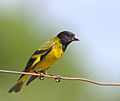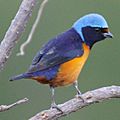Finch facts for kids
Quick facts for kids True finch |
|
|---|---|
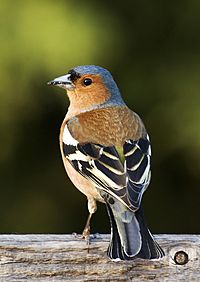 |
|
| Adult male Chaffinch (Fringilla coelebs) of the Fringillinae |
|
| Scientific classification | |
| Kingdom: | |
| Phylum: | |
| Class: | |
| Subclass: | |
| Order: | |
| Suborder: | |
| Infraorder: | |
| Family: |
Fringillidae
Vigors, 1825
|
Finches are passerine songbirds in the family Fringillidae. They are small to medium-sized passerine birds in the family Fringillidae.
Finches have stout conical bills adapted for eating seeds and nuts and often have colourful plumage.
They occupy a great range of habitats where they are usually resident and do not migrate. They have a worldwide distribution except for Australia and the polar regions.
The family Fringillidae contains more than two hundred species divided into fifty genera. It includes species known as siskins, canaries, redpolls, serins, grosbeaks and euphonias.
Most species are native to the Southern Hemisphere, but one subfamily is endemic to the Neotropics, one to the Hawaiian Islands, and one genus is found only in the Palaearctic (Eurasia and north Africa).
Many birds in other families are also commonly called "finches" They include
- • some species in the very similar-looking waxbills (family Passeridae, of the Old World tropics and Australia;
- • several groups of the bunting and American sparrow family (Emberizidae);
- • Darwin's 'finches' of the Galapagos Islands, which provided evidence of natural selection. They are now recognized to be peculiar tanagers (Thraupidae).
Some species are being imported or smuggled into other countries and sold as exotic pets.
Description

The smallest "classical" true finches are the Andean siskin (Spinus spinescens) at as little as 9.5 cm (3.8 in) and the lesser goldfinch (Spinus psaltria) at as little as 8 g (0.28 oz). The largest species is probably the collared grosbeak (Mycerobas affinis) at up to 24 cm (9.4 in) and 83 g (2.9 oz), although larger lengths, to 25.5 cm (10.0 in) in the pine grosbeak (Pinicola enucleator), and weights, to 86.1 g (3.04 oz) in the evening grosbeak (Hesperiphona vespertinus), have been recorded in species which are slightly smaller on average. They typically have strong, stubby beaks, which in some species can be quite large; however, Hawaiian honeycreepers are famous for the wide range of bill shapes and sizes brought about by adaptive radiation. All true finches have 9 primary remiges and 12 rectrices. The basic plumage colour is brownish, sometimes greenish; many have considerable amounts of black, while white plumage is generally absent except as wing-bars or other signalling marks. Bright yellow and red carotenoid pigments are commonplace in this family, and thus blue structural colours are rather rare, as the yellow pigments turn the blue color into green. Many, but by no means all true finches have strong sexual dichromatism, the females typically lacking the bright carotenoid markings of males.
Distribution and habitat
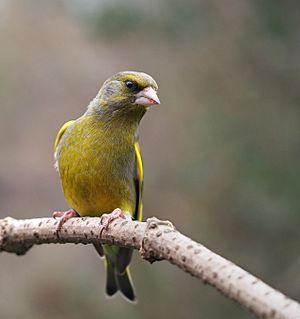
The finches have a near-global distribution, being found across the Americas, Eurasia and Africa, as well as some island groups such as the Hawaiian islands. They are absent from Australasia, Antarctica, the Southern Pacific and the islands of the Indian Ocean, although some European species have been widely introduced in Australia and New Zealand.
Finches are typically inhabitants of well-wooded areas, but some can be found on mountains or even in deserts.
Diet
The finches are primarily granivorous, but euphoniines include considerable amounts of arthropods and berries in their diet, and Hawaiian honeycreepers evolved to utilize a wide range of food sources, including nectar. The diet of Fringillidae nestlings includes a varying amount of small arthropods.
Behaviour
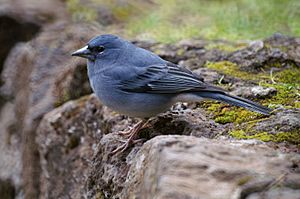
True finches have a bouncing flight like most small passerines, alternating bouts of flapping with gliding on closed wings. Most sing well and several are commonly seen cagebirds; foremost among these is the domesticated canary (Serinus canaria domestica). The nests are basket-shaped and usually built in trees, more rarely in bushes, between rocks or on similar substrate.
Images for kids
-
Euphonias, like this thick-billed euphonia, were once treated as tanagers instead of finches.
-
American goldfinch (Spinus tristis) male (left) and female (right) in Johnston County, North Carolina, USA
-
Hooded siskin (Spinus magellanicus)
-
ʻIʻiwi (Drepanis coccinea), a Hawaiian honeycreeper
-
Male violaceous euphonia (Euphonia violacea)
-
European goldfinch (Carduelis carduelis)
-
Gran Canaria blue chaffinch (Fringilla polatzeki)
-
Desert finch (Rhodospiza obsoleta)
-
Pine grosbeak (Pinicola enucleator)
-
Evening grosbeak (Hesperiphona vespertina)
-
Yellow-breasted greenfinch (Chloris spinoides)
-
Yellow canary (Crithagra flaviventris)
See also
 In Spanish: Fringílidos para niños
In Spanish: Fringílidos para niños






